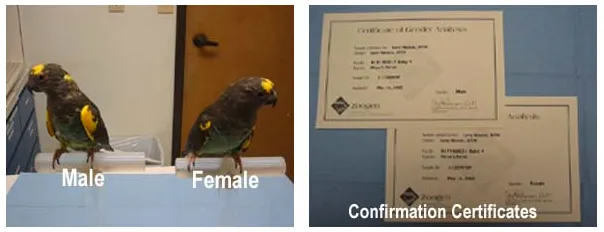
Why do most species of birds need blood DNA analysis to determine sexual gender? First, the majority of bird species look phenotypically (externally) identical. Second, exotic pet birds have a unique anatomical arrangement where the gonads (ovaries or testicles) are located internally in the body at the level just in front of the kidneys along the backbone. Also, the normal gonads are quite small which precludes radiographs as a way to determine the gender of the bird. For many years, endoscopic evaluation was performed by anesthetizing the bird, make a small incision, and then visually looking at the gonads to determine the bird's gender. It was generally accurate, but had the potential for human error in both the performing of the technique and interpretation of the visual examination of the gonads.
Blood DNA sexing in psittacine birds was first pioneered by Joy Halverson, DVM in 1985. The technique has since been adapted, refined, improved, and scientifically verified for all the pet bird species owned in the United States to a level of 99.99% accuracy. The sample size is but a few drops of blood obtained via the toenail of the bird and sent in a special kit to Halverson's laboratory, Zoogen, Inc, in Davis, California. Faxed results are received approximately 5 days later with a written certificate of verification to follow. Other laboratories now offer DNA sexing, but do not have the experience and data verification compared to Dr. Halverson's lab and that is why The BIRD Clinic only uses Zoogen, Inc.
The BIRD Clinic offers this service to all our existing clients at a flat laboratory rate with no office call charge or preparation fee and all testing is performed by Dr. Nemetz. An appointment is required.

